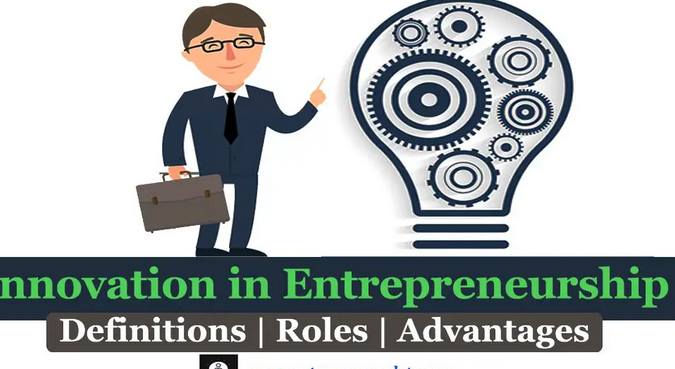In today’s dynamic business landscape, the key to staying competitive and achieving long-term success lies in fostering entrepreneurship and innovation. These two vital components are like twin engines propelling businesses toward growth, adaptability, and sustainable development. This article will explore how entrepreneurship and innovation work hand in hand, driving business progress and why they are indispensable in the contemporary business world.

The Entrepreneurial Spirit: A Catalyst for Innovation
Entrepreneurship is the driving force behind innovation. Entrepreneurs are individuals who identify opportunities, take calculated risks, and create value by introducing new products, services, or processes to the market. They possess a unique set of qualities that enable them to see beyond the status quo and envision a better future.
They embrace uncertainty, which is an inherent part of the innovation process. In doing so, they challenge existing norms and encourage creative thinking within their organizations.
Innovation: The Lifeblood of Entrepreneurship
Innovation, on the other hand, is the practical realization of entrepreneurial ideas. It involves translating creative concepts into tangible products, services, or processes that offer a competitive advantage. Innovation takes various forms, such as technological advancements, process improvements, or even novel marketing strategies.
For example, consider the tech giant Apple. Entrepreneurial leaders like Steve Jobs and Tim Cook have consistently driven innovation within the company, resulting in groundbreaking products like the iPhone, iPad, and MacBook. These innovations not only transformed Apple’s fortunes but also disrupted entire industries.
The Symbiotic Relationship
Entrepreneurs are the architects of innovation, while innovation provides entrepreneurs with the tools needed to stay ahead of the curve. This symbiotic relationship has several key aspects:
Identifying Opportunities
Entrepreneurs identify opportunities for innovation by recognizing gaps in the market, consumer needs, or emerging trends. They are adept at spotting areas where innovation can create value.
Risk-Taking and Experimentation
Entrepreneurship encourages calculated risk-taking. Entrepreneurs are willing to experiment, even if it means encountering setbacks along the way.
Building a Culture of Innovation
Successful entrepreneurs foster a culture of innovation within their organizations. They encourage employees to think creatively, propose new ideas, and challenge the status quo. This culture allows innovation to thrive.
Adapting to Change
Innovation enables businesses to adapt to changing market conditions. It equips them with the tools needed to pivot, reinvent, and stay relevant. This adaptability is critical in today’s rapidly evolving business landscape.
Sustainable Growth
Entrepreneurship and innovation lead to sustainable growth. Businesses that continuously innovate are more likely to maintain a competitive edge and navigate economic downturns successfully.
Real-World Examples
Several real-world examples illustrate the profound impact of entrepreneurship and innovation in business:
Amazon
Amazon, founded by Jeff Bezos, exemplifies entrepreneurial innovation. Starting as an online bookseller, Bezos transformed Amazon into a global e-commerce and technology giant. The company’s innovative endeavours include Amazon Web Services (AWS), Kindle e-readers, and the development of drone delivery systems.
Tesla
Elon Musk, the visionary entrepreneur behind Tesla, has disrupted the automotive industry with innovative electric vehicles (EVs). Tesla’s cutting-edge technology, autonomous driving features, and energy solutions are driving the shift toward sustainable transportation.
Airbnb
Airbnb, co-founded by Brian Chesky, Joe Gebbia, and Nathan Blecharczyk, redefined the hospitality industry. Their entrepreneurial vision introduced a platform that allows individuals to monetize their homes, creating a new market segment within the sharing economy.
Challenges and Barriers to Entrepreneurship and Innovation
While entrepreneurship and innovation are powerful drivers of business success, they come with their own set of challenges and barriers. Some of these include:
Resource Constraints
Startups and small businesses often struggle with limited resources, making it challenging to invest in research and development.
Resistance to Change
Established organizations may resist innovation due to fear of disruption or reluctance to depart from traditional practices.
Regulatory Hurdles
Certain industries face stringent regulations that can impede innovation or make it more costly and time-consuming.
Talent Shortages
Finding and retaining innovative talent can be difficult, especially in highly competitive industries.
Collaborative Ecosystems
Entrepreneurship and innovation thrive in collaborative ecosystems. Many tech hubs, incubators, and accelerators have emerged worldwide, fostering an environment where startups, investors, and established companies work together to drive innovation.
Corporate Innovation Initiatives
Large corporations are increasingly recognizing the importance of innovation to maintain their competitiveness. They are setting up innovation labs, partnering with startups, and dedicating resources to research and development.
Intellectual Property and Patents
Innovation often leads to the creation of intellectual property (IP) and patents. These protect the rights of innovators and can be valuable assets for businesses.
Globalization
Businesses often collaborate across borders, sharing ideas and technologies to create products and services that cater to diverse markets.
Conclusion
In conclusion, entrepreneurship and innovation are the twin engines that propel businesses into the future. They enable organizations to adapt, grow, and thrive in an ever-changing world. In today’s business landscape, embracing entrepreneurship and innovation is not just an option; it’s a necessity for those looking to remain competitive and make a lasting impact.
As entrepreneurs continue to identify opportunities and take calculated risks, and as innovators turn visionary ideas into reality, the business world will continue to evolve, shaping industries, markets, and societies for years to come.